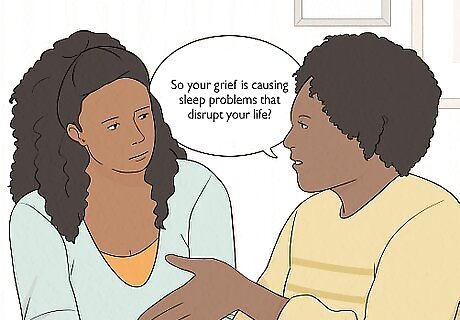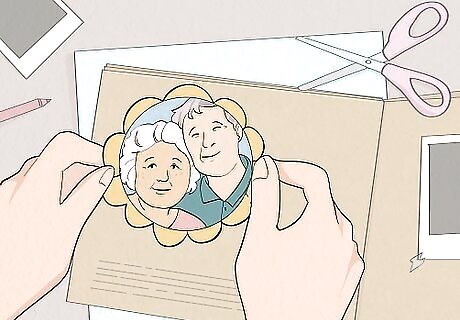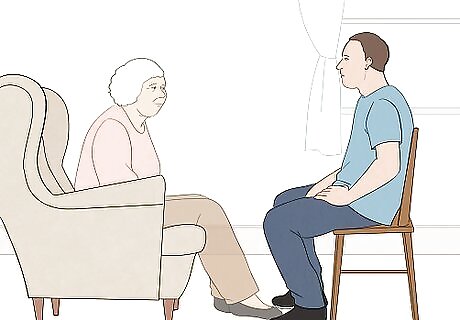
views
Practicing Helpful Counseling Techniques

Act as a companion. Each person’s experience with grief is different. That means that no level of expertise will equip you to tell the person in mourning how they should respond. Your role is to provide company, listen, and validate their feelings. Don’t tell, listen. Constantly reinforce that their response is normal and natural. Encourage them to use their own skills to cope with grief. If they are an artist, encourage them to use this ability to express their feelings. Help them understand and recognize their feelings. Help them develop a schedule that allows them to manage their daily tasks while reducing unnecessary outside stressors. Remember that your job is to be there, not to take away the pain. That is impossible. Your job is to support them, not to try to fix them.

Validate feelings. It is important to make it clear that you understand the person's feelings. Be sure that they know that such feelings are natural and that people experience grief differently. It might be useful to explain some of the common responses to grief and make it clear that they are natural. Those who experience instrumental grief focus on problem solving and try to control emotional responses. Those who experience intuitive grieving have intense emotional experiences that might include depression and thoughts about mortality. It is common for people to blame themselves, feel anger, hopelessness, anxiety, and withdrawal from the world.

Ask open questions. Don’t ask leading questions or “yes” and “no” questions. Ask big, broad questions, that encourage them to think about their feelings and explore the subjects that they are interested in. Make it clear that you want to know what they feel, but are not questioning the validity of their feelings. Do not ask “why” questions. These make it sound as if you do not understand or support their feelings. Ask broad questions like “How do you feel?” Ask “What bothers you the most?” Instead of asking “Why do you feel that way?” ask “Could you give me specific examples?”

Paraphrase responses. When you are trying to get to the core of their problems, try giving a short summary of what you think they have told you. This will demonstrate that you are listening and might help them get a better grip on what is bothering them the most. If they tell you, “I stay up every night thinking about him. When I go to work I am tired and can’t think clearly. I am getting more and more nervous and depressed because I can’t function during the day.” Ask, “So your grief is causing sleep problems that disrupt your life?”

Reflect ther feelings. When you get a sense for how they feel, verify that you have correctly understood their emotions. This is a way to demonstrate that you are listening and that you have developed an emotional connection. Try, “Sounds like you are very angry about what has happened.” Alternatively, “It sounds like you are having difficulty understanding your emotions.”

Refrain from unsupportive behavior. Everything you do should be directed at them. Anything that suggests your focus is elsewhere will be counterproductive. You should avoid forcing your own solutions upon them. Do not watch the clock. Do not take notes. Do not look around the room. Do not try to read too much into their feelings and impose your own idea or their feelings on them. Do not preach or lecture about what they should do. Refrain from giving too much advice or asking too many questions. Do not respond too quickly. Allow moments of silence. Do not change the subject. Do not talk too much about yourself.
Developing a Supportive Persona

Look them in the eye. Look them in the eye to show that you are interested in and engaged with what they are saying. Allow your face to demonstrate that you are emotional and supportive. Be dynamic and engaged, possibly nodding in affirmation.

Keep your body open and relaxed. Crossed legs and arms may suggest that you are closed off or uninviting. Try to sit straight up, with your limbs open. Your body should appear relaxed and you can gesture with your hands to show emotional support. Also be sure that your body is facing directly toward the grieving person to indicate that you are engaged with them. Sit on the same level as the person you are talking to. Do not take a chair that allows you to tower over them, or them over you. This creates a sense of power imbalance that is not helpful for open conversation.

Talk like you care. Talk naturally and allow your voice to show emotion. Try to develop a soothing tone in your voice. Your conversation style should also demonstrate that you are there to listen. Don’t interrupt them, jump from topic to topic, or rush them to an answer. It is okay to leave periods of silence. These allow them to think about their feelings and ensure that they do not feel that they have been cut off or is rushed to respond.
Using Rituals for Remembrance

Get them to plan ahead for important dates. Holidays or important dates in the person's relationship with the person they lost can trigger feelings of loss. Encourage them to plan ahead to commemorate those days. This can help them create a feeling of continuity with the past or create the sense that you are moving on. While it is particularly useful to develop a ritual for special dates, there is no reason why the griever shouldn’t plan to celebrate or remember the deceased any other day.

Encourage them to commemorate with ritual. There is a plethora of rituals they can use to remember their loved lost one. Which one they pick depends on their relationship with the person and what it was that once brought them together. Some examples include: Preparing a meal that the deceased enjoyed. Watch a movie that the person enjoyed. Go on a walk, possibly where the two of had been in the past, and remember times spent together. Buy flowers on important days. Travel somewhere the deceased wanted to go. Listen to music that reminds the grieving person of the deceased. Look through a photo album.

Encourage them to express their grief through art. Ask them to write fiction, personal essays, or poetry that expresses and identifies feelings and blockages. You can encourage artists to paint or draw. Starting a journal can be an important step for dealing with emotions. Ask them to try writing about the life of the person they lost. Alternatively, have them write about how that person has influenced them. Remind them that the deceased lives on through them.

Create a memory book. Memory books can help in the grieving process. Compile mementos, photos or stories about the deceased person. This helps one come to terms with the magnitude of the loss and to focus on the realities of one’s new life without forgetting the lost loved one.

Use the open-chair technique. Place an open chair opposite the grieving person and ask them to imagine the deceased person sitting in that chair. Give the bereaved person the opportunity to speak to the person in the chair and say all the things that they would like to have said to that person. Playing out situations from the past or rehearsing difficult future situations may help bring closure. The use of objects and memorabilia, such as jewelry and other objects which the bereaved person is comfortable with, can be used to facilitate talking and bringing the mourning process to a close.

Don't push. Some people will want to clear their heads or process their loss before trying to commemorate their loved one. Many people have difficulty talking about what has happened. It is your job to give the grieving party ideas about how to move on. It is not your job to force them to do something they do not want to do.




















Comments
0 comment